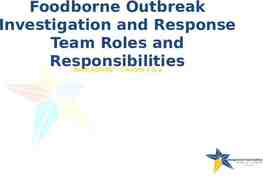THE WATER RESEARCH COMMISSION & THE SABS PRESENTS WORKSHOP ON
63 Slides5.04 MB
THE WATER RESEARCH COMMISSION & THE SABS PRESENTS WORKSHOP ON ISO 24521 On-Site Domestic Wastewater Services SABS and WATER RESEARCH COMMISSION 1
PRESENTATION TOPICS Background to the ISO 24521 Introduction Objectives of ISO 24521 Principal Objectives of wastewater utility Components of Basic onsite-domestic WW systems Management of basic domestic WW systems Planning & Construction Operation & Maintenance Health & Safety issues SABS and WATER RESEARCH COMMISSION 2
BACKGROUND ISO 24521 is an international management standard, written from an operator's perspective. It provides guidance for the management of basic on-site domestic wastewater services, using appropriate technologies in their entirety at any level of development. ISO 24521 is applicable to both publicly and privately operated basic on-site domestic wastewater (black- and greywater) services for single and multiple dwellings. SABS and WATER RESEARCH COMMISSION 3
BACKGROUND The standard covers: Guidelines for the management of basic on-site domestic wastewater services from the operator’s perspective, including maintenance techniques, training of personnel and risk considerations; Guidelines for the management of basic on-site domestic wastewater services from the perspective of users; Guidance on the design and construction of basic on-site domestic wastewater systems; Guidance on planning, operation and maintenance, and health and safety issues. SABS and WATER RESEARCH COMMISSION 4
INTRODUCTION The are 3 ISO Standards that address the water services: Activities relating to drinking water and wastewater services: ISO 24510: Guidelines for the assessment and for the improvement of the service to users ISO 24511: Guidelines for the management of wastewater utilities and for the assessment of wastewater services ISO 24512: Guidelines for the management of drinking water utilities and for the assessment of drinking water services SABS and WATER RESEARCH COMMISSION 6
Benefits of the Adoption of ISO 24521 OBJECTIVES OF ISO 24521 Public health and safety Occupational health and safety Environmental protection Sustainable development Hygienic, safe and pleasant to use for communities Restored dignity of users Safe to operation of on-site domestic wastewater systems Production of by-products SABS and WATER RESEARCH COMMISSION 9
INITIAL FOCUS ISO 24521 Enhancing the effectiveness of the existing on-site plants by providing guidance on Management to meet the Operability / Management issues Is a developed guidance for the management of basic on-site domestic wastewater services, using technologies in their entirety at any level of development, as applicable It is standardisation of a framework for the definition and measurement of service activities relating to drinking water supply systems and wastewater systems SABS and WATER RESEARCH COMMISSION 10
PRINCIPAL OBJECTIVES FOR WASTEWATER UTILITIES SABS and WATER RESEARCH COMMISSION 11
OBJECTIVES FOR WASTEWATER UTILITIES Protection of public health Protection of users and operators Meeting the needs & expectations of users Provision of service under normal & emergency situations Sustainability of basic on-site domestic wastewater system Promotion of sustainable development of the community SABS and WATER RESEARCH COMMISSION 13
PROTECTION OF PUBLIC HEALTH Safe and sanitary disposal of wastewater should be a public health priority. Wastewater should be disposed of in a manner that ensures that: Drinking water supplies are not threatened; Direct human exposure is not possible; Waste is inaccessible to vectors, insects, rodents or other possible carriers; Odour or aesthetic nuisances are not created SABS and WATER RESEARCH COMMISSION 14
PROTECTION OF PUBLIC HEALTH Water Sources endangered Wetlands threatened SABS and WATER RESEARCH COMMISSION 15
PROTECTION OF USERS AND OPERATORS Protective equipment when handling wastewater for users & Operators Appropriate training must be conducted Health protection of the owners of the premises or workers providing emptying services must be accounted for SABS and WATER RESEARCH COMMISSION 16
Meeting the needs & expectations of users Improvement of current living conditions: Safety, privacy Research: Number of users, cultural acceptance, Economic costs User needs& Expectations Communication commitment & service delivery Re-use End- user needs & expectation SABS and WATER RESEARCH COMMISSION 17
Provision of service under normal & emergency situations Wastewater services should be available on a continuous basis Where an emergency applies, emergency calls & response actions should be initiated User interfaces intended for emergency situations should be portable/easy to assemble Potential short term emergency solutions: SABS and WATER RESEARCH COMMISSION 18
Sustainability of basic on-site domestic wastewater system Demand for Re-use of sanitation system product Nutrients Recovery From faeces & urine and used at household level as fertilizer or soil improver. Safety and hygiene requirements must be considered. Need to consider health & safety requirements. Sustainable(Assets) on-site sanitation systems Revenue Sources To ensure cost recovery od services. To ensure financially stability. Maintenance of onsite domestic system Provide capacity to meet current & future needs. Periodically desludging & preventative maintenance so that assets meet criterion for functional lifespan. SABS and WATER RESEARCH COMMISSION 19
Promotion of sustainable development of the community According to ISO 24511: The Wastewater facilities must address: Sustainable development Ability for communities to grow & prosper within the environmental, infrastructural & economic resources available to it Promoting efficient use of resources through recycling & reuse Instituting pollution prevention techniques by eliminating/ separating pollutants at source SABS and WATER RESEARCH COMMISSION 20
Promotion of sustainable development of the community Strategic priorities for management of water resources Attention to be given to overall management of water resources Quantitative and qualitative aspects of management Quantitative Aspect of water management Efficient use of water Retention & re-use Discharge SABS and WATER RESEARCH COMMISSION 21
Promotion of sustainable development of the community According to ISO24521: The Wastewater facilities must address Integrated water resources management Renewable energy Utilization of treated wastewater residues: reuse of treated wastewater residues in agriculture for the provision of food, when applicable SABS and WATER RESEARCH COMMISSION 22
COMPONENTS OF BASIC ON-SITE DOMESTIC WASTEWATER SYSTEMS SABS and WATER RESEARCH COMMISSION 23
Components of basic on-site domestic wastewater systems Basic on-site domestic wastewater systems generally comprise: User interface Collection and Transport Treatment Disposal/ Re-use SABS and WATER RESEARCH COMMISSION 24
User-Interface (Containment) Technologies with which the user comes into contact and access the sanitation system Toilets and washing facilities are the user interfaces Toilets may be designed to allow the separation of urine and faeces SABS and WATER RESEARCH COMMISSION 25
User-Interface (Containment) User interfaces including but not limited to: Simple ventilated/unventilated pit latrine; Double ventilated improved pit latrine/fossa alterna; Dry toilets, e.g. urine diverting dry toilet (UDT), composting toilet Ventilated pit latrines Pour flush toilet; Waterless urinal; Cistern flush toilet; Washing facilities, e.g. greywater sink Urinary diverting Toilet Waterless urinal SABS and WATER RESEARCH COMMISSION Double ventilated improved pit latrines 26
Collection & Transport Collection facilities contain human excreta awaiting transportation, including drums and containers, vaults and chambers, and double pit system SABS and WATER RESEARCH COMMISSION 28
Collection & Transport Collection facilities include: Transportation: Carts above ground tank Tricycles human-powered emptying motorized (pump or vacuum) emptying any other human-powered multiple-wheeled vehicles trucks vacuum tankers SABS and WATER RESEARCH COMMISSION 29
TREATMENT SABS and WATER RESEARCH COMMISSION 30
TREATMENT TWO GROUPS OF TREATMENT TECHNOLOGIES: Technologies primarily for the treatment of wastewater may include Septic tank with one or more compartments without discharge Septic tank system with discharge and adequate filtration Up flow anaerobic sludge blanket reactor (UASB) SABS and WATER RESEARCH COMMISSION 31
TREATMENT Technologies primarily for the treatment of sludge may include: Sedimentation/thickening ponds Unplanted drying beds Planted drying beds Co-composting Anaerobic biogas reactor SABS and WATER RESEARCH COMMISSION 32
DISPOSAL / RE-USE SABS and WATER RESEARCH COMMISSION 33
DISPOSAL / RE-USE The recovery of resources for economic use by post treatment should be considered when designing basic on-site domestic wastewater systems. Nutrients recovery from faeces & urine Effluent use in irrigation Land application of treated/stabilized sludge (biosolids) as fertilizer/soil conditioner Energy recovery option of sludge treatment SABS and WATER RESEARCH COMMISSION 34
DISPOSAL / RE-USE UKZN research team and their partners: PRG, UKZN 2019 SABS and WATER RESEARCH COMMISSION 35
Management of basic on-site domestic wastewater systems SABS and WATER RESEARCH COMMISSION 36
Management of basic on-site domestic wastewater systems Independent management of system function and stakeholder communication: SABS and WATER RESEARCH COMMISSION 37
Basic Management Activities Developing objectives and establishing action plans The objectives, strategies and processes of the system and users must be clear defined. Financial sustainability of the system The financial stability of all resources is important to ensure that the wastewater systems function as designed, are operated as intended and meet the objectives for sustainability and the criterion for lifespan. SABS and WATER RESEARCH COMMISSION 38
Basic Management Activities Sustainability of the assets Must include monitoring and planning for continuous technical functioning and the continuing availability of financial resources so that the needs and requirements of the users are met with respect to treatment of the human waste/wastewater and lifespan criterion for the asset. Customer relations Where basic on-site domestic wastewater systems are managed by people other than the owners of the premises, managing the customer relationship requires that the customers (user/users) accept the human waste/wastewater treatment system and agree that their needs and concerns are known and resolved. SABS and WATER RESEARCH COMMISSION 39
Stakeholder relations Developing plans for support of stakeholders SABS and WATER RESEARCH COMMISSION 40
Education and/or training of stakeholders Education and/or training should be well planned and sustainable The education and/or training should cover health and hygienic practices of using the basic on-site domestic wastewater system and could be provided as follows: For key local authorities and field staff: proper training on principles and technical solutions For field workers: practical training concerning the construction and management of the basic on-site system, as well as empowerment methods For household and community members: acquisition of skills in building, operating and maintaining basic on-site domestic wastewater systems, including awareness raising on hygienic practices of the basic on-site domestic wastewater system SABS and WATER RESEARCH COMMISSION 41
Education and/or training of stakeholders Education could be conducted through: Public awareness campaigns One on one basis School curriculum Media Community-based organization/community user groups Community engagement/mobilization programs (government or donor), such as communityled total sanitation School health clubs/youth groups SABS and WATER RESEARCH COMMISSION 42
Environmental management Environmental management of basic on-site domestic wastewater systems should: Promote sustainability of the policy objectives for wastewater projects by protecting and preserving water quality and water resources. To assess the impact of basic on-site domestic wastewater collection, treatment and disposal, an environmental check list should be specifically developed in accordance with local conditions. SABS and WATER RESEARCH COMMISSION 43
Environmental management An environmental check list could include: The number of persons whose waste will be treated The expected monthly flow The nature of the expected flow, i.e. whether it is just domestic (as it should be in the case of basic on-site systems) or mixed with institutional or industrial waste The type of treatment unit: septic tank, alternative treatment system (e.g. aeration), wetlands The nature of the soils surrounding the effluent bed The proximity to natural water sources The use of the natural water sources Access to the area by livestock SABS and WATER RESEARCH COMMISSION 44
Risk Assessment Risk management should begin in the planning stage of the basic on-site domestic wastewater system and should include all aspects of : Design Construction Implementation Operation and Maintenance SABS and WATER RESEARCH COMMISSION 45
Risk Assessment The risk management should include the following steps: Problem formulation: A planning process for generating and evaluating hypotheses about the effects that might occur and identify the risks Analysis: Typically includes both the site-specific analysis and characterization of risk causation (occurrence or exposure) and the more general analysis or characterization of risk effects Risk characterization: The process of combining the estimates of occurrence or exposure with the exposure-response relationships from the analysis of effects to estimate the magnitude and (if possible) probability of effects and resulting consequences Development and implementation of a dynamic plan: The plan should include monitoring operation, preventative maintenance and corrective action to eliminate or control the risks SABS and WATER RESEARCH COMMISSION 46
Risk Assessment Categorization of risks: Risks may be grouped in the following categories: public health and safety environmental impact socio-economic Operational risk of transportation of wastewater: Risks associated with the collection, treatment and transportation of wastewater and its constituents Risk framework: The framework for evaluating risk of system performance should be flexible enough to accommodate various types of basic on-site domestic wastewater systems SABS and WATER RESEARCH COMMISSION 47
Risk Assessment The operational risk model for wastewater should account for: Backup of the treatment system Surface breakthrough from structural failure Contamination of the land Transport into drinking water wells and groundwater Potentially exposed populations Exposure of biota SABS and WATER RESEARCH COMMISSION 48
Site assessment for risks The site model for evaluating basic on-site system risks should account for: location of the basic on-site domestic wastewater treatment system location of residences and water wells topography groundwater sources to prevent adverse impacts from contamination on water sources like wells and boreholes surface water sources to prevent adverse impacts or nutrient over enrichment from contamination soils and slopes which may create effluent plumes potentially exposed populations SABS and WATER RESEARCH COMMISSION 49
Causes of failure The failure mode can be divided into two categories, design deficiency or process variation, which can be described in terms of something that can be corrected or can be controlled. The potential failure modes are identified through answers to the following questions: In what way can this subsystem fail to perform its intended function? What can go wrong although the subsystem is manufactured/assembled to specifications? If the subsystem function was tested, how would its failure mode be recognized? How will the environment contribute to or cause a failure? In the application of the subsystem, how will it interact with other subsystems? SABS and WATER RESEARCH COMMISSION 50
Planning & construction SABS and WATER RESEARCH COMMISSION 51
Planning & construction Economic Costs Protection of Environment Planning & construction Criteria Protection of public health Risk & Assessment & Management Cultural Acceptance SABS and WATER RESEARCH COMMISSION -Stakeholders Involvement - Awareness raising methods 52
Operation & Maintenance SABS and WATER RESEARCH COMMISSION 54
Operation & Maintenance Basic On-site domestic wastewater services should have: Written and visual instructions for operational and maintenance plans Disposal plans Education and training plans Planning of operation and maintenance should take into consideration defined responsibilities SABS and WATER RESEARCH COMMISSION 55
Operation & Maintenance Developing instructions for operational and maintenance plans, disposal plans and/or education and training plans SABS and WATER RESEARCH COMMISSION 56
Developing operational plans and instruction Sequence of all essential operation must be: defined for the treatment of domestic waste define tasks required to maintain the process including residual disposal & effluent discharge Documentation using visual representations or instructions These documents should minimize problems due to language or education More detailed working/ user instructions must be prepared whenever required SABS and WATER RESEARCH COMMISSION 57
Developing operational plans and instruction SABS and WATER RESEARCH COMMISSION 58
Developing maintenance plans and instructions Maintenance Plan of the system should be both Preventative and Reactive Preventative plan includes: Maintenance performed at planned condition-oriented or scheduled intervals in order to prevent, minimize or delay failures or ineffective treatment of domestic wastewater SABS and WATER RESEARCH COMMISSION 59
Developing maintenance plans and instructions Benefits of Preventative Maintenance Preventative maintenance eliminates many conditions that cause unplanned maintenance. Reduces probability of failure Improves safety Cost effective Minimize overhaul frequency Energy savings Flexibility Decreases downtime SABS and WATER RESEARCH COMMISSION 60
Developing maintenance plans and instructions Reactive maintenance includes: Maintenance performed following a failure of the equipment, treatment process or shutdown It involves activities necessary to repair or restore the system to a satisfactory condition or level of performance. Steady degration of equipment performance Respond to emergency SABS and WATER RESEARCH COMMISSION 61
Developing plans and instructions for collection of waste Domestic wastewater is collected from different types of toilets Whenever possible faeces and urine should be separated to facilitate reuse Tools to collect Faeces & Urine: Double pit system Plastic or metal containers or drum. Excreta can also be collected in vaults and chambers. Instructions: The collection systems should be structurally resistant to cracks Must be checked regularly for leakage. The capacity should be monitored to prevent overflow of the excreta SABS and WATER RESEARCH COMMISSION 62
Developing plans and instructions for collection of waste Implementation, operation and collection techniques should: Include regular removal of excreta Safe handling of faeces and urine, as they may contain pathogens – develop SOP The sustainability and continuity of the entire sanitation system depends on good organization and management of transportation systems Transportation depends on : Quantity (Volume) of wastewater and sludge Characteristics of wastewater and sludge (both treated and untreated) SABS and WATER RESEARCH COMMISSION 63
Developing plans and instructions for collection of waste Different types of transportation techniques include: Cartage techniques include cycles and pushcarts mechanical emptying systems sewer systems SABS and WATER RESEARCH COMMISSION 64
Health and safety issues SABS and WATER RESEARCH COMMISSION 65
Health & Safety Regular medical check-ups: For users, service providers & operators who handle waste Protective equipment: Must be provided for users & operators when handling waste Monitor for any infectious or parasitic diseases: For stakeholders who come in contact with wastewater and/or sub-products of basic onsite domestic wastewater. SABS and WATER RESEARCH COMMISSION 66
Health & Safety Education/Training: Should be conducted to avoid any health risk. Training is necessary for proper transport and handling of waste/wastewater to prevent or minimize operator risk and risk to the public (community) or environment It should be confirmed that the operator is sufficiently well-trained before given permission to transport waste/wastewater Discontinued use In the event of outbreak of diseases, short term emergency solutions SABS and WATER RESEARCH COMMISSION 67
Public health programmes To mitigate any effects of sub-products of basic on-site domestic wastewater systems. The health programs should include: Medical surveillance of concerned stakeholders Testing of sub-products for any pathogenic microorganisms or other hazardous materials Review of the use of technologies of the system to establish any improper use or faults that could promote activity of pathogenic microorganisms and, where possible, the kind of routes of exposure as a result of using the system Health and hygiene education, including promotion of washing hands with soap and/or an equivalent washing agent Pre-evaluation of a particular technology for possible failure that could promote the activity of pathogenic microorganisms as well as other hazards, where feasible SABS and WATER RESEARCH COMMISSION 68
THANK YOU! SABS & WRC team QUESTIONS Content collated by Pollution Research Group, University of KwaZulu-Natal SABS and WATER RESEARCH COMMISSION SABS and WATER RESEARCH COMMISSION 69




































































